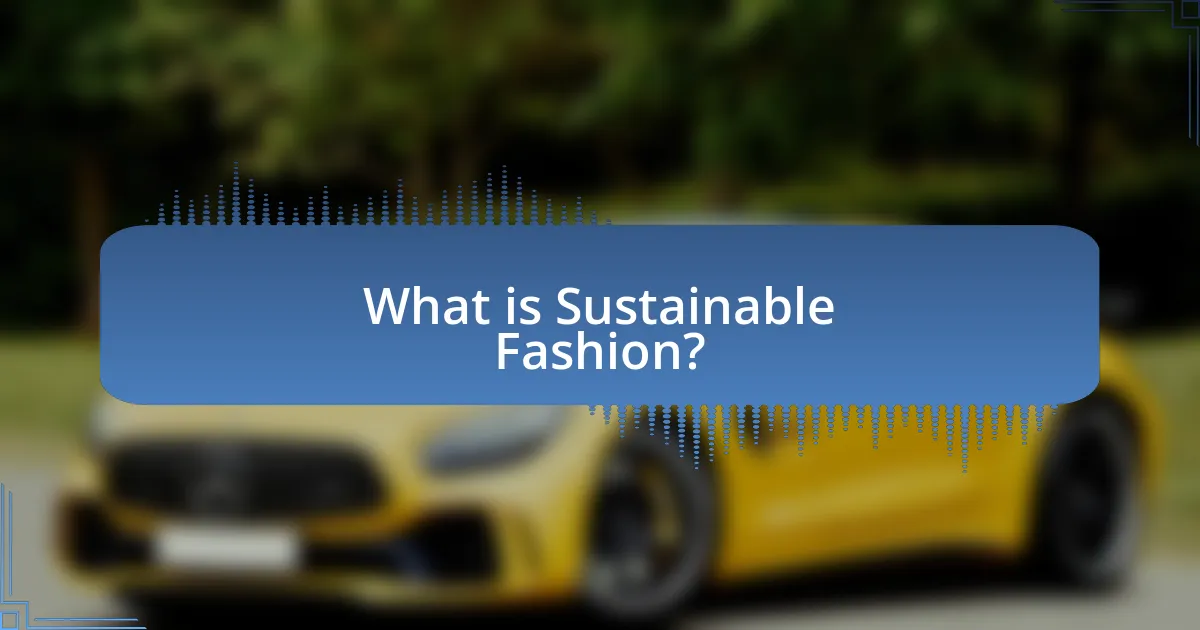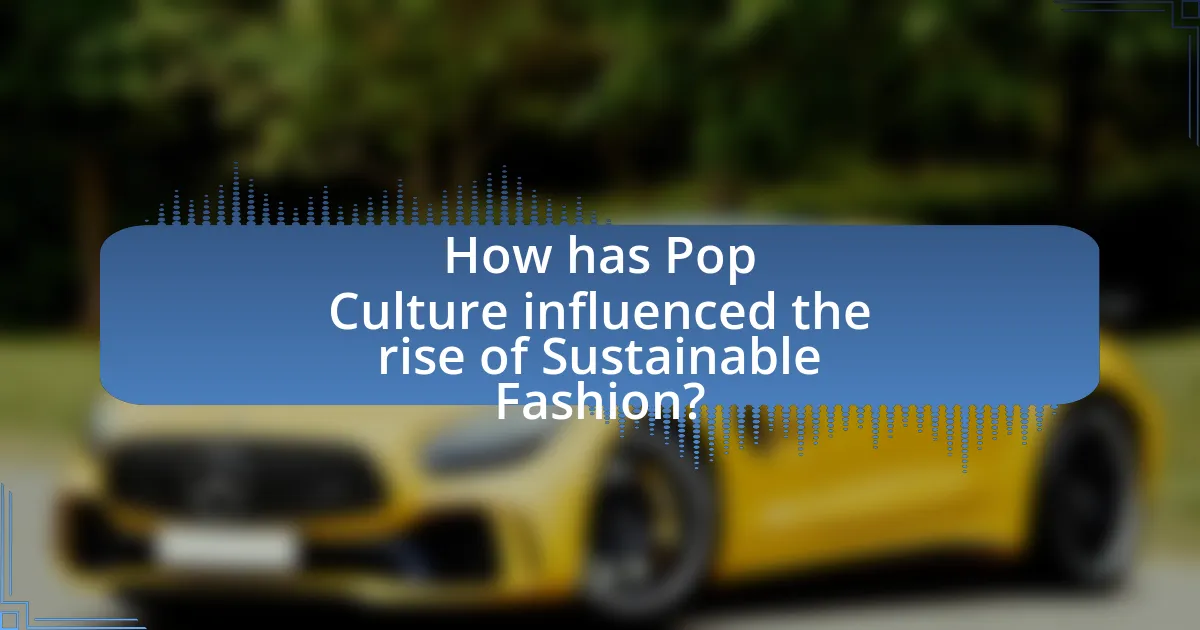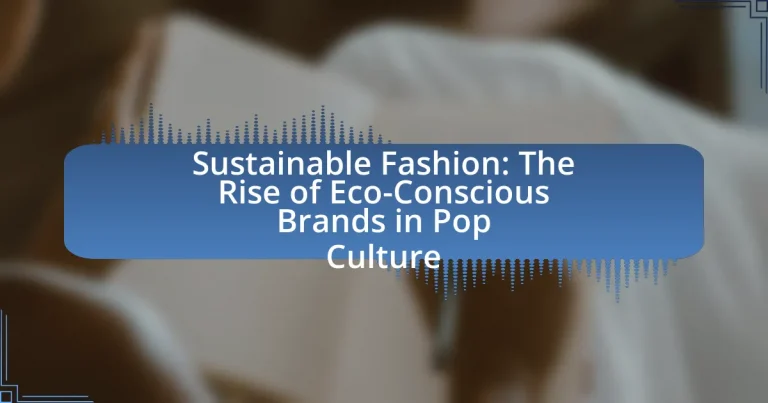Sustainable fashion is an approach that emphasizes environmental and social responsibility in clothing design, production, and consumption. The article explores the emergence of sustainable fashion as a response to the negative impacts of the fast fashion industry, highlighting historical influences, consumer attitudes, and the importance of eco-conscious brands. It discusses the environmental consequences of traditional fashion practices, the role of certifications in building consumer trust, and the impact of pop culture on the movement. Additionally, the article addresses challenges faced by eco-conscious brands in the mainstream market and offers practical steps for consumers to support sustainable fashion.

What is Sustainable Fashion?
Sustainable fashion is an approach to clothing design, production, and consumption that prioritizes environmental and social responsibility. This concept encompasses practices such as using eco-friendly materials, reducing waste, and ensuring fair labor conditions. According to the Global Fashion Agenda’s 2021 report, the fashion industry is responsible for 10% of global carbon emissions, highlighting the urgent need for sustainable practices to mitigate environmental impact.
How did Sustainable Fashion emerge as a concept?
Sustainable Fashion emerged as a concept in response to the environmental and social impacts of the fast fashion industry. The late 20th century saw increasing awareness of issues such as pollution, waste, and labor exploitation associated with mass production of clothing. In the 1990s, organizations like the Ethical Fashion Forum and initiatives such as the Eco-Age campaign began advocating for more responsible practices in the fashion industry. This movement gained momentum with the rise of consumer demand for transparency and ethical sourcing, leading to the establishment of certifications like Fair Trade and Global Organic Textile Standard (GOTS). By the 2000s, sustainable fashion became a significant trend, influencing major brands and designers to adopt eco-friendly materials and ethical labor practices, thereby reshaping the industry landscape.
What historical events influenced the rise of Sustainable Fashion?
The rise of Sustainable Fashion was significantly influenced by the environmental movement of the 1960s and 1970s, which raised awareness about pollution and resource depletion. Events such as the publication of Rachel Carson’s “Silent Spring” in 1962 highlighted the dangers of pesticides and environmental degradation, prompting a shift in public consciousness. Additionally, the 1992 Earth Summit in Rio de Janeiro brought global attention to sustainable development, further encouraging the fashion industry to adopt eco-friendly practices. The 2000s saw the emergence of fast fashion, which led to increased scrutiny over its environmental impact, catalyzing a counter-movement towards sustainability. These historical milestones collectively shaped the principles and practices of Sustainable Fashion today.
How do consumer attitudes shape the Sustainable Fashion movement?
Consumer attitudes significantly shape the Sustainable Fashion movement by driving demand for eco-friendly products and influencing brand practices. As consumers increasingly prioritize sustainability, brands are compelled to adopt ethical sourcing, reduce waste, and implement transparent supply chains to meet these expectations. For instance, a 2021 survey by McKinsey & Company found that 67% of consumers consider sustainability when making a purchase, indicating a strong preference for brands that align with their values. This shift in consumer behavior not only encourages existing brands to adopt sustainable practices but also fosters the emergence of new eco-conscious brands, further propelling the movement forward.
Why is Sustainable Fashion important in today’s society?
Sustainable fashion is important in today’s society because it addresses environmental degradation and promotes ethical labor practices. The fashion industry is responsible for approximately 10% of global carbon emissions and significant water pollution, making sustainable practices essential for reducing ecological harm. Additionally, sustainable fashion emphasizes fair wages and safe working conditions, countering the exploitation often seen in fast fashion. By prioritizing eco-friendly materials and ethical production, sustainable fashion contributes to a more responsible and conscious consumer culture, aligning with the growing demand for transparency and accountability in the industry.
What environmental impacts does traditional fashion have?
Traditional fashion has significant environmental impacts, primarily through resource depletion, pollution, and waste generation. The fashion industry is responsible for 10% of global carbon emissions, largely due to energy-intensive production processes and transportation. Additionally, conventional textile production consumes vast amounts of water; for instance, producing a single cotton t-shirt requires approximately 2,700 liters of water. Furthermore, the use of harmful chemicals in dyeing and finishing processes contaminates water bodies, affecting aquatic ecosystems and human health. Lastly, traditional fashion contributes to substantial textile waste, with an estimated 92 million tons of textiles discarded annually, leading to overflowing landfills and increased greenhouse gas emissions.
How does Sustainable Fashion contribute to social responsibility?
Sustainable fashion contributes to social responsibility by promoting ethical labor practices and reducing environmental impact. This approach ensures that workers in the fashion industry receive fair wages and safe working conditions, addressing issues such as exploitation and child labor. For instance, brands that adhere to sustainable practices often source materials from suppliers who comply with labor standards, thereby fostering a more equitable industry. Additionally, sustainable fashion reduces waste and pollution through the use of eco-friendly materials and production methods, which helps protect communities and ecosystems. According to the Global Fashion Agenda’s 2021 report, sustainable practices can significantly lower carbon emissions, further supporting social responsibility by mitigating climate change effects that disproportionately impact vulnerable populations.

What are the key characteristics of Eco-Conscious Brands?
Eco-conscious brands prioritize sustainability, ethical production, and environmental responsibility in their operations. These brands often utilize eco-friendly materials, such as organic cotton or recycled fabrics, and implement sustainable manufacturing processes that minimize waste and reduce carbon footprints. For instance, a study by the Global Fashion Agenda highlights that sustainable practices can lead to a 30% reduction in greenhouse gas emissions in the fashion industry. Additionally, eco-conscious brands typically advocate for fair labor practices, ensuring that workers are treated ethically and compensated fairly. This commitment to social responsibility further distinguishes them in the marketplace.
How do Eco-Conscious Brands differentiate themselves from traditional brands?
Eco-conscious brands differentiate themselves from traditional brands primarily through their commitment to sustainability and ethical practices. These brands prioritize environmentally friendly materials, such as organic cotton and recycled fabrics, and often implement transparent supply chains to ensure fair labor practices. For instance, a study by McKinsey & Company found that 66% of consumers are willing to pay more for sustainable brands, highlighting the growing demand for eco-friendly products. Additionally, eco-conscious brands frequently engage in initiatives like carbon offsetting and waste reduction, which further distinguishes them from traditional brands that may prioritize profit over environmental impact.
What materials do Eco-Conscious Brands typically use?
Eco-conscious brands typically use sustainable materials such as organic cotton, hemp, Tencel, recycled polyester, and bamboo. These materials are chosen for their lower environmental impact compared to conventional fabrics. For instance, organic cotton is grown without harmful pesticides, reducing soil and water pollution, while Tencel, made from sustainably sourced wood pulp, is produced in a closed-loop process that minimizes waste. Recycled polyester, derived from post-consumer plastic bottles, helps reduce plastic waste in landfills. These choices reflect a commitment to sustainability and ethical production practices in the fashion industry.
How do Eco-Conscious Brands ensure ethical labor practices?
Eco-conscious brands ensure ethical labor practices by implementing strict supply chain transparency and adhering to fair labor standards. These brands often conduct regular audits of their suppliers to verify compliance with labor laws, ensuring that workers receive fair wages, safe working conditions, and reasonable hours. For instance, brands like Patagonia and Everlane publish detailed information about their factories and labor practices, demonstrating their commitment to ethical standards. Additionally, many eco-conscious brands partner with organizations such as Fair Trade to certify their products, which guarantees that labor practices meet specific ethical criteria. This approach not only fosters accountability but also builds consumer trust, as evidenced by a 2021 survey indicating that 66% of consumers are willing to pay more for sustainable brands that prioritize ethical labor practices.
What role do certifications play in identifying Eco-Conscious Brands?
Certifications play a crucial role in identifying eco-conscious brands by providing verified standards that demonstrate a brand’s commitment to sustainability. These certifications, such as Fair Trade, Global Organic Textile Standard (GOTS), and the Forest Stewardship Council (FSC), require brands to meet specific environmental and social criteria, ensuring transparency and accountability in their practices. For instance, GOTS certification mandates that at least 70% of the textile must be organic, which helps consumers easily recognize brands that prioritize eco-friendly materials and ethical labor practices. This verification process builds consumer trust and encourages brands to adopt more sustainable practices, ultimately influencing purchasing decisions in the market.
Which certifications are most recognized in the Sustainable Fashion industry?
The most recognized certifications in the Sustainable Fashion industry include Global Organic Textile Standard (GOTS), OEKO-TEX Standard 100, and Fair Trade Certified. GOTS certifies organic textiles, ensuring environmentally and socially responsible production processes. OEKO-TEX Standard 100 tests textiles for harmful substances, promoting safety for consumers and the environment. Fair Trade Certified focuses on fair labor practices and sustainable livelihoods for workers in the fashion supply chain. These certifications are widely acknowledged for their rigorous standards and commitment to sustainability, making them essential benchmarks in the industry.
How do certifications impact consumer trust in Eco-Conscious Brands?
Certifications significantly enhance consumer trust in eco-conscious brands by providing verified proof of sustainable practices. When brands obtain certifications from recognized organizations, such as Fair Trade or Global Organic Textile Standard, they demonstrate compliance with specific environmental and ethical standards. Research indicates that 66% of consumers are willing to pay more for sustainable brands, reflecting a direct correlation between certifications and consumer willingness to invest in eco-friendly products. Furthermore, a study published in the Journal of Business Research found that consumers perceive certified brands as more credible and trustworthy, leading to increased brand loyalty and purchase intentions. Thus, certifications serve as a critical factor in building consumer confidence in eco-conscious brands.

How has Pop Culture influenced the rise of Sustainable Fashion?
Pop culture has significantly influenced the rise of sustainable fashion by promoting eco-conscious brands through celebrity endorsements and social media platforms. High-profile figures like Emma Watson and Leonardo DiCaprio have publicly advocated for sustainable practices, increasing awareness and consumer interest in eco-friendly fashion. Additionally, social media campaigns, such as #SustainableFashion, have created a community around sustainable choices, encouraging brands to adopt environmentally friendly practices. According to a 2021 report by McKinsey & Company, 67% of consumers consider sustainability when making fashion purchases, highlighting the direct impact of pop culture on consumer behavior and the fashion industry’s shift towards sustainability.
What examples exist of celebrities promoting Sustainable Fashion?
Celebrities promoting sustainable fashion include Emma Watson, who has advocated for eco-friendly brands and served as a UN Women Goodwill Ambassador, emphasizing the importance of sustainable practices in the fashion industry. Another example is Stella McCartney, a designer known for her commitment to cruelty-free and sustainable fashion, often collaborating with celebrities like Rihanna and Kate Hudson to promote her eco-conscious collections. Additionally, Leonardo DiCaprio has supported sustainable fashion initiatives through his foundation, highlighting the environmental impact of the fashion industry. These celebrities leverage their influence to raise awareness and encourage consumers to consider sustainability in their fashion choices.
How do celebrity endorsements affect consumer behavior towards Eco-Conscious Brands?
Celebrity endorsements significantly enhance consumer behavior towards eco-conscious brands by increasing brand visibility and credibility. Research indicates that consumers are more likely to purchase products endorsed by celebrities they admire, particularly when those celebrities advocate for sustainability. For instance, a study published in the Journal of Advertising Research found that 67% of consumers reported a higher likelihood of buying eco-friendly products when promoted by a trusted celebrity. This effect is amplified when the celebrity’s personal values align with environmental sustainability, leading to a stronger emotional connection with the brand. Consequently, celebrity endorsements not only drive sales but also foster a positive perception of eco-conscious brands among consumers.
What role do social media platforms play in promoting Sustainable Fashion trends?
Social media platforms play a crucial role in promoting sustainable fashion trends by facilitating the rapid dissemination of information and fostering community engagement around eco-conscious practices. These platforms enable brands to showcase their sustainable initiatives, connect with consumers who prioritize ethical consumption, and share educational content about the environmental impact of fashion. For instance, Instagram and TikTok have become popular venues for influencers and brands to highlight sustainable fashion choices, leading to increased visibility and consumer interest. According to a 2021 report by McKinsey & Company, 67% of consumers consider sustainability when making a purchase, indicating that social media’s influence on consumer behavior is significant in the context of sustainable fashion.
How are fashion events adapting to highlight Sustainable Fashion?
Fashion events are adapting to highlight Sustainable Fashion by incorporating eco-friendly practices, showcasing sustainable brands, and emphasizing ethical production methods. For instance, major fashion weeks are now featuring dedicated segments for sustainable designers, such as the “Sustainable Fashion Day” at London Fashion Week, which promotes brands committed to environmentally friendly practices. Additionally, events are increasingly using digital platforms to reduce carbon footprints, with virtual shows and online presentations becoming more common. According to a report by McKinsey & Company, 67% of fashion executives believe sustainability will be a key driver of growth in the coming years, reflecting a significant shift in industry priorities.
What initiatives are being taken at major fashion weeks to promote sustainability?
Major fashion weeks are implementing various initiatives to promote sustainability, including the use of eco-friendly materials, waste reduction strategies, and the integration of circular fashion concepts. For instance, New York Fashion Week has introduced a sustainability-focused platform called “The Fashion Sustainability Initiative,” which encourages designers to adopt sustainable practices and materials. Additionally, London Fashion Week has mandated that all participating designers showcase at least one sustainable collection, emphasizing the importance of ethical production methods. These initiatives are supported by industry reports indicating that sustainable fashion is gaining traction, with a 2021 McKinsey report highlighting a 30% increase in consumer interest in sustainable brands.
How do collaborations between brands and artists enhance the visibility of Sustainable Fashion?
Collaborations between brands and artists enhance the visibility of Sustainable Fashion by leveraging the artists’ influence and creative reach to promote eco-friendly practices. When artists partner with sustainable brands, they create unique, limited-edition products that attract attention and generate buzz, effectively reaching wider audiences. For instance, the collaboration between Stella McCartney and various artists has not only showcased sustainable materials but also emphasized the importance of ethical fashion, resulting in increased consumer awareness and engagement. This synergy between artistic expression and sustainable branding amplifies the message of eco-consciousness, making it more appealing and accessible to the public.
What challenges do Eco-Conscious Brands face in the mainstream market?
Eco-conscious brands face significant challenges in the mainstream market, primarily due to consumer skepticism and higher production costs. Many consumers question the authenticity of eco-friendly claims, leading to a lack of trust in brands that promote sustainability. Additionally, the production of sustainable goods often incurs higher costs, which can result in elevated retail prices that deter price-sensitive consumers. According to a 2021 survey by McKinsey, 66% of consumers expressed concern about sustainability, yet only 15% are willing to pay a premium for eco-friendly products. This discrepancy highlights the difficulty eco-conscious brands encounter in balancing sustainability with affordability while gaining consumer trust in a competitive market.
How do pricing strategies affect the accessibility of Sustainable Fashion?
Pricing strategies significantly influence the accessibility of sustainable fashion by determining the affordability and market reach of eco-friendly products. High pricing often limits consumer access, as many sustainable brands position themselves as premium offerings, which can alienate budget-conscious shoppers. For instance, a study by the Global Fashion Agenda indicates that sustainable fashion items can be up to 30% more expensive than conventional alternatives, creating a barrier for widespread adoption. Conversely, brands that implement competitive pricing or offer tiered pricing models can enhance accessibility, allowing a broader demographic to engage with sustainable fashion. This dynamic illustrates that effective pricing strategies are crucial for increasing the market penetration of sustainable fashion and promoting eco-conscious consumer behavior.
What misconceptions exist about Eco-Conscious Brands among consumers?
Consumers often mistakenly believe that eco-conscious brands are significantly more expensive than traditional brands. This misconception arises from the perception that sustainable materials and ethical production processes inherently lead to higher costs. However, studies indicate that while some eco-friendly products may carry a premium, many eco-conscious brands offer competitive pricing, especially as sustainable practices become more mainstream and production scales increase. For instance, a report by McKinsey & Company highlights that the cost of sustainable materials is decreasing as technology advances, making eco-conscious options more accessible to a broader audience.
What practical steps can consumers take to support Sustainable Fashion?
Consumers can support sustainable fashion by choosing to buy from eco-conscious brands that prioritize ethical production practices. This includes researching brands for their sustainability certifications, such as Fair Trade or GOTS (Global Organic Textile Standard), which indicate adherence to environmental and social standards. Additionally, consumers can reduce their fashion footprint by purchasing second-hand clothing, which extends the life cycle of garments and minimizes waste. According to a report by the Ellen MacArthur Foundation, extending the life of clothes by just nine months can reduce carbon, water, and waste footprints by around 20-30%. Furthermore, consumers can advocate for sustainable practices by engaging with brands on social media, promoting transparency, and supporting legislation that encourages sustainable practices in the fashion industry.
How can consumers identify truly sustainable brands when shopping?
Consumers can identify truly sustainable brands when shopping by looking for certifications, transparency in sourcing, and ethical practices. Certifications such as Fair Trade, Global Organic Textile Standard (GOTS), and B Corp indicate adherence to sustainability standards. Brands that provide detailed information about their supply chain, including materials used and labor practices, demonstrate a commitment to ethical production. Research shows that 66% of consumers are willing to pay more for sustainable brands, highlighting the growing demand for transparency and accountability in the fashion industry.
What are some tips for building a sustainable wardrobe?
To build a sustainable wardrobe, prioritize quality over quantity by selecting durable, timeless pieces that can withstand trends. Investing in high-quality garments reduces the frequency of replacements, thereby minimizing waste. Additionally, choose brands that prioritize ethical production practices, such as using organic materials and ensuring fair labor conditions. Research shows that the fashion industry is responsible for 10% of global carbon emissions, highlighting the importance of conscious consumerism. Lastly, consider second-hand shopping, as it extends the lifecycle of clothing and reduces demand for new production, contributing to a more sustainable fashion ecosystem.


